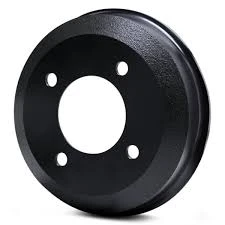When Should You Replace Your Brake Drums for Optimal Vehicle Safety and Performance
How Often Should You Replace Brake Drums?
Brake drums play a crucial role in your vehicle's braking system, especially for those cars equipped with drum brakes. While many drivers are accustomed to disc brakes, drum brakes remain prevalent in various vehicles, particularly older models and light trucks. Understanding how often to replace brake drums is essential for maintaining optimal braking performance and ensuring safety on the road.
Understanding Brake Drums
Brake drums are circular metal components that house the brake shoes. When you apply the brakes, the brake shoes expand against the inner surface of the drum, creating the friction needed to slow down or stop the vehicle. This system is reliable; however, over time, both the brake shoes and the drum can experience wear and tear.
Signs That Your Brake Drums Need Replacement
1. Unusual Noises If you hear a grinding or squealing noise when applying the brakes, it could be a sign that your brake drums are worn out. This noise often results from the brake shoes making contact with the drum surface or the wear indicators, which signal the need for replacement.
2. Vibration A noticeable vibration in the brake pedal or steering wheel while braking can indicate that the brake drums are out of round or warped. This uneven surface can lead to uneven wear on the brake shoes and reduced braking efficiency.
4. Visual Damage Regular visual inspections can help you catch issues early. Look for cracks, scoring, or excessive wear on the brake drums. If you notice any significant damage, it's best to replace the drums.
how often to replace brake drums

How Often Should You Replace Brake Drums?
The lifespan of brake drums varies based on several factors, including driving habits, the type of vehicle, and the materials used. However, as a general rule, brake drums can last anywhere from 30,000 to 70,000 miles.
1. Driving Conditions Frequent stop-and-go traffic, driving in hilly or mountainous areas, and heavy towing can accelerate the wear on brake drums. In these cases, you might need to replace your brake drums more often.
2. Type of Brakes Vehicles that use a combination of disc and drum brakes may have different maintenance schedules. It's vital to consult your vehicle’s owner manual for manufacturer recommendations.
3. Regular Maintenance Having your braking system inspected during regular vehicle maintenance can help you catch problems early. Mechanics typically check for wear and tear on the brake drums, shoes, and other components, allowing you to address issues before they lead to more significant problems.
Conclusion
Replacing brake drums is not just about following a mileage guideline; it’s also about paying attention to the warning signs your vehicle gives you. Regular inspections, paying attention to unusual noises or sensations, and understanding your driving habits will help you determine when it's time to replace your brake drums.
Remember, proper maintenance of your vehicle's braking system is vital for your safety and the safety of others on the road. If you’re unsure about the condition of your brake drums, it’s always best to consult a professional mechanic. Keeping your braking system in check will help ensure that you can stop safely and effectively whenever necessary. Prioritizing brake maintenance is a simple way to promote road safety and extend the lifespan of your vehicle’s braking components.
-
Truck Drum Brake Spring Replacement ProcedureNewsAug.22,2025
-
Evolution Of Brake Drum Function Designs In Automotive HistoryNewsAug.22,2025
-
Drum Brake Motor Thermal Management SolutionsNewsAug.22,2025
-
Essential tools for brakes and drums repair jobsNewsAug.22,2025
-
Trailer Drum Brake Self-Adjusting Mechanisms ExplainedNewsAug.22,2025
-
Brake Drum Types in Vintage Auto RestorationNewsAug.22,2025
-
Rear Drum Brakes Maintenance TipsNewsAug.04,2025


